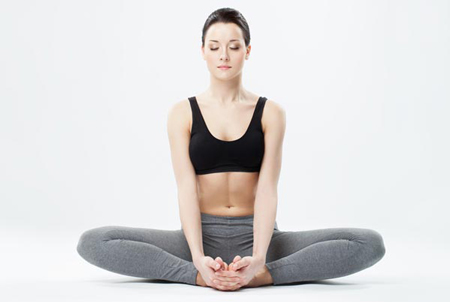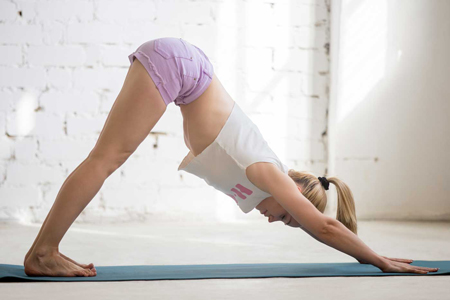Seven tips for cultivating a steady home yoga practice
By Kimberley Mok
It’s that time of the year when the resolve behind those earnestly made New Year’s resolutions to eat better or exercise more flag and falter. The same goes for establishing a regular yoga or meditation practice at home: it starts with good intentions, but somewhere along the way, one’s initial verve can get dulled by the daily grind or by some other mysterious psychological resistance to following through, even if you know practicing at home can help you save the money and time that it takes to go to a public class. In any case, if you find yourself wavering a bit, here are a few tips to help you get a home yoga practice started and to keep it going.

1. Don’t pressure yourself.
Probably easy to say, but harder to do in our driven and competitive society. Nevertheless, it’s key to allow yourself to have no expectations of what a “good” yoga practice looks or feels like, and accept where you are each day – physically, mentally, emotionally and energetically – without judgment and independent of whether you are able to make it onto the mat or not that day. Ease the critical self-talk. Even the practice of transforming self-judgment into self-acceptance can have enormous benefits.
2. Set an intention before your practice.
All right, so that may sound a bit like setting an expectation or goal, but there is a difference between an intention, versus expectations and goals. An intention focuses your awareness on cultivating a certain a way of being, writes Phillip Moffitt over at Yoga Journal:
“Setting intention, at least according to Buddhist teachings, is quite different than goal making. It is not oriented toward a future outcome. Instead, it is a path or practice that is focused on how you are being in the present moment. Your attention is on the ever-present now in the constantly changing flow of life. You set your intentions based on understanding what matters most to you and make a commitment to align your worldly actions with your inner values.”
As you gain insight through meditation, wise reflection, and moral living, your ability to act from your intentions blossoms. It is called a practice because it is an ever-renewing process. You don’t just set your intentions and then forget about them; you live them every day.
Setting an intention that’s meaningful to you – whether it’s cultivating love or gratitude, or releasing negativity – will help you deepen your inner practice both on and off the mat.
3. Stick to a set sequence.
Series like the Sun Salutation (SURYA NAMASKAR) and Moon Salutation (CHANDRA NAMASKAR) are easy to follow, and great for building a foundation for a strong home practice. If you feel otherwise uninspired to do a lengthy yoga ASANA (posture) practice, you can do three repetitions of either salutation series and call it a day.

In addition, one of the biggest advantages of styles or schools of yoga that have a predetermined series of postures to follow – such as Ashtanga, Bikram, Integral or Sivananda – is that having a set series of movements means that you can concentrate on observing if there’s any evolution in your practice. Plus, following a set sequence can also help you cultivate a deeper, meditative flow as you repeat the practice on a daily basis.
4. Try free online classes.
Alternatively, if you are someone who does not like routine in any kind of practice, you can follow online yoga classes, allowing you to steadily practice in the comfort and privacy of your own home.
5. Habits form out of repetition and environmental cues.
From a psychological point of view, habits are patterns of behaviours that are formed in response to cues or triggers found in one’s environment. So it might be helpful to formulate some kind of routine around your new practice: perhaps doing some postures when you come home after work, or before going to bed. Designating a quiet, peaceful place in your home as a practice space helps too. Turn off the phone and computer if needed. Remember, it may take a few weeks to several months for a new habit to stick – so be patient but consistent.
6. Function, not form.
While there are some general guidelines for finding alignment and stability in each asana or posture, it’s important to remember that every body is different, so there is no one way that a pose should look. Whether there is a modification to your pose that helps you strain less or breathe better, your body will intuitively know what feels good and right. This is one of the biggest advantages of a home practice: the ability to tailor your practice to you, modifying or holding poses for as long as needed. No matter what, listen to your body and be kind to yourself as you go through your practice.
7. Meditate, do deep breathing and rest in SAVASANA (corpse pose) after every practice.
Spending time in some kind of restorative pose like SAVASANA (where you lie down on your back with the arms alongside the body and palms facing up), or meditating and observing your breath and mindspace for even a few minutes is crucial. Adding these tools helps you integrate the more subtle benefits of the practice, and also establishes a balance between ease and effort.
If you have time, you could do an extended, guided deep relaxation (YOGA NIDRA) using a recording. Complete relaxation and cultivating mindfulness is key to a releasing the tension that gets stored up in our bodies, minds and spirits.
Ultimately, in whatever form it may take, yoga is a holistic practice that can help us to let go whatever it is that prevents us from seeing that we are all connected – to our inner selves, to each other and to the universe as a whole.
yogaesoteric
December 21, 2019
Also available in:
 Français
Français
